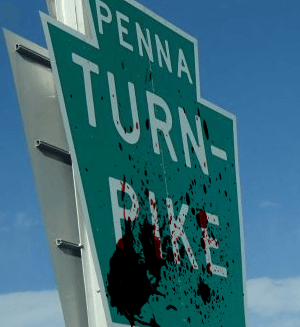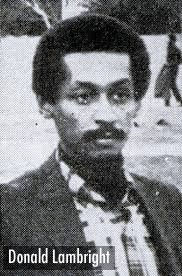Ricochet is the best place on the internet to discuss the issues of the day, either through commenting on posts or writing your own for our active and dynamic community in a fully moderated environment. In addition, the Ricochet Audio Network offers over 50 original podcasts with new episodes released every day.
 Sidebars of History: Death Stalks the Turnpike
Sidebars of History: Death Stalks the Turnpike
 The Southern Pennsylvania Railroad was supposed to compete against the mighty Pennsylvania. Among its backers was Andrew Carnegie, who didn’t like the rates charged by the dominant railroad to move his steel. In 1883, workers started blasting holes in the Alleghenies in the western part of the state. Sensing the threat to their business, the owners of the Pennsylvania came to an agreement more amenable to Carnegie and construction stopped. After two years, there wasn’t a inch of track, but the mountains had nine new holes.
The Southern Pennsylvania Railroad was supposed to compete against the mighty Pennsylvania. Among its backers was Andrew Carnegie, who didn’t like the rates charged by the dominant railroad to move his steel. In 1883, workers started blasting holes in the Alleghenies in the western part of the state. Sensing the threat to their business, the owners of the Pennsylvania came to an agreement more amenable to Carnegie and construction stopped. After two years, there wasn’t a inch of track, but the mountains had nine new holes.
Fifty years later, these tunnels would form the basis for the PA Turnpike, originally a 162-mile stretch of road from US 30 east of Pittsburgh to US 11 just west of the capital of Harrisburg. When the first section opened in October 1940, it became America’s first super highway. Twice in its history, the Turnpike became America’s highway of death. Not from the occasional accident, but through the deliberate actions of a mass murderer.
During a one week period in July of 1953 two drivers were murdered as they slept in their commercial trucks along the pike. A third was shot in the jaw and survived. That took place in Lisbon, Ohio about 18 miles from the Turnpike’s western termination.
All were ambushed, shot in the head with a .32, and their wallets emptied. On the 25th, the night of the first murder, there was a six-car pile up nearby that killed several people; police assumed it was caused by the gunman fleeing the scene.
Truckers armed themselves in fear. The Teamsters started armed patrols and the truck lines offered a $5,000 reward. The media nicknamed him “The Phantom of the Turnpike.”
 In early October there was a break in the case. The third victim’s watch showed up in a Cleveland pawn shop. The name on the ticket? John Wesley Wable. He had taken a room in a boarding house there and skipped town. When he left he gave his local girlfriend a present: a German-made .32 pistol.
In early October there was a break in the case. The third victim’s watch showed up in a Cleveland pawn shop. The name on the ticket? John Wesley Wable. He had taken a room in a boarding house there and skipped town. When he left he gave his local girlfriend a present: a German-made .32 pistol.
Ballistics proved a match. Wable was arrested near Santa Fe, New Mexico after holding up a gas station in Albuquerque.
Charged with murder, Wable was extradited back to Pennsylvania. But unlike the last time he was behind bars, now he proclaimed his innocence. The real murderer, he said, was a man from Pittsburgh named “Jim Parks” who had borrowed his gun. He also claimed to have bought the watch off of Parks and admitted to having pawned it. “Parks” was never found and Wable was found guilty in March of 1954. That December, a judge sentenced him to die in the electric chair and he was executed in September of ’55.
Sixteen years later, on an April Easter weekend in 1969, Donald Lambright murdered three and injured 17 during a shooting spree with an M1 and a carbine on the Turnpike. Contemporary press reports presented conflicting stories on Lambright’s background. It was said — alternately — that he was a college student, a secondary teacher from Philadelphia, or a man who had recently quit his $10K per year job at the State Employment Bureau in Cleveland (That would be around $68K in today’s money.)
 What was known is that he was the son of the black comic actor Stepin Fetchit (real name Lincoln Perry) and his second wife, Winifred. His parents divorced when Donald was only two. When his mother married again, this time to Cleveland physician Middleton Lambright, the doctor adopted the boy.
What was known is that he was the son of the black comic actor Stepin Fetchit (real name Lincoln Perry) and his second wife, Winifred. His parents divorced when Donald was only two. When his mother married again, this time to Cleveland physician Middleton Lambright, the doctor adopted the boy.
He was also known to be active in the black militancy movement of the times. His uncle, Howard Johnson, Jr., a sociologist with New York City’s Upward Bound Poverty Movement, told The New York Times his nephew was paranoid about whites.
“It is an unholy tragedy that a brilliant young man could be so frustrated by his life in the United States that he could only see achieving success through destruction. He thought shooting might be a necessary tactic, sometime.”
The main victims were a Philadelphia couple, Ignatius and Ruby Kennan, who were both shot in the face as they traveled to see their oldest son who was enrolled as a grad student at Penn State. Two other motorists were shot in the face and the rest were injured by flying glass or the result of crashing their automobiles. It was reported that after Lambright finished with his shooting spree, he pulled over to the side of the road, killed his wife and then turned the gun on himself.
Amazingly, the first press reports that went out on the AP after Lambright was identified as the shooter made no mention of his race or parental heritage.
Later, Johnson and Lambright’s daughter Lisa, blamed J. Edgar Hoover and the FBI. She claimed that there was a long-haired white man reported in the car and that he was forcing Lambright to drive while he did the shooting. Johnson, before his death in 2001, claimed the FBI may have framed Donald, doing everything they could to crush the black liberation movement.
With no security cameras dotting the landscape like they do today, no one will really know what happened in either case. But both stories reflect back to today’s realities. You’re never going to be able to stop the ancient evil that inhabits the hearts of men, you’re never going to stop the hatred incited by political movements whose sole motivation is revenge, and the inability to connect the dots will always be one of our greatest failures.
Published in Culture, History



Excellent piece.
Sad and fascinating stories. People forget that this sort of thing has been, and unfortunately always will be, with us.
My father traveled the PA turnpike from Pgh to Philadelphia and back every two weeks in a truck during the fifties and sixties. He often stoped for a nap in the pull off areas. I can remember being very frightened as a child of eight as was my whole family. If my memory serves me right a book was done on this subject or it might have been a newspaper series. While the police investigated they found all kinds of strange things one of which were several traveling cat houses. Even after Wable was caught there was a lot of fear. Thanks EJ you made me think of my wonderful father who died in 1974. Also one of those tunnels became a fiery death for a bunch of people during a head on collision.The tunnels were one lane in each direction in those days. My Dad missed that by just a few minutes.
EJ, thanks very much for an interesting, well written piece.
Good article.
Good stuff EJ. I particularly liked the turnpike history. I used to drive a 150 mile stretch of the turnpike several times per year, from Carlisle in the east to New Stanton in the western part of the state, that was quite close to the original complete road. From reading the plaques at the service stops I thought I knew the part about the original path. But the plaques simply say that the road was built on the right-of-way and using the tunnels from the old railroad. They don’t mention that they never actually built the railroad.
My mom grew up in Hazleton, and we used to make the drive from Toledo on the turnpike before I-80 was complete. As a kid, I was fascinated by the tunnels, but heading so far south made the trip very long. My dad hated the turnpike and was thrilled when the alternate route was complete. I never knew about these incidents…parents then could still protect their children from these stories. I’m sure, however, that knowledge of these things fed into my parents dislike of the road…and they drove on it in their various travels throughout the 50s and 60s.
I drove the Turnpike many times on the trip between Chicago and DC. Getting through the old tunnels was always an adventure as two lanes merged into a single lane. They were extremely dark and narrow and you could feel the change in air pressure in the car as the trucks passed you a few feet away going in the opposite direction.
EJ,
Lambright’s story is especially chilling. The parents apparently said “it was a protest against racism”. How could killing innocent people at random be a protest. This is the absurdity that the media refuses to jump on whenever it is expressed.
To the extent that this excuses the behavior it also incites it.
Regards,
Jim
One of the scariest drives of my life. The road was crumbling, freezing rain with patchy ice and heavy, fast traffic. Two trucks up the runaway truck ramps (saw one of them go), and at the bottom of a long hill, a trucker standing, scratching his head, looking at one of his tires aflame.
Whenever Dave Carter talks about trucking, this was what I imagined him having to deal with on a regular basis (and why I nixed log-haul trucking as a career option).
There were really bad accidents when I was young, especially on holiday weekends. The Tuscarora tunnel stands out in my mind in that regard but it may have been no worse than the rest.
I drove it from Harrisburg to Pittsburgh this past summer – probably the first time in that direction.
You had to pay attention. Long stretches were separated from the opposing lanes by only a short metal guard rail – no median strip. Going from east to west was like traveling ahead in time, as you came to the more modern Ohio and Indiana turnpikes.
Wikipedia has an interesting article on the abandoned tunnels.
https://en.wikipedia.org/wiki/Abandoned_Pennsylvania_Turnpike